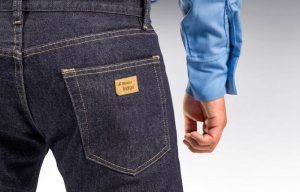
Cone Denim and Westex extend FR denim partnership
UK based start up company, MMT Textiles Ltd has invented and patented a method of constructing bio-responsive fibres and yarns so that they react to humidity levels in a micro-climate. The porosity of subsequent knitted, woven or non-woven fabrics increases with high levels of humidity or wetness in the micro-climate, facilitating the release of moisture, or decreases in low level humidity or dry conditions, improving insulation. This is referred to as ‘the pine con

31st July 2009
Innovation in Textiles
|
London
![]() UK based start up company, MMT Textiles Ltd has invented and patented a method of constructing bio-responsive fibres and yarns so that they react to humidity levels in a micro-climate. The porosity of subsequent knitted, woven or non-woven fabrics increases with high levels of humidity or wetness in the micro-climate, facilitating the release of moisture, or decreases in low level humidity or dry conditions, improving insulation. This is referred to as ‘the pine cone effect’.
UK based start up company, MMT Textiles Ltd has invented and patented a method of constructing bio-responsive fibres and yarns so that they react to humidity levels in a micro-climate. The porosity of subsequent knitted, woven or non-woven fabrics increases with high levels of humidity or wetness in the micro-climate, facilitating the release of moisture, or decreases in low level humidity or dry conditions, improving insulation. This is referred to as ‘the pine cone effect’.
MMT’s Dr Veronika Kapsali says: “Conventional fibres swell as they absorb moisture. This causes the yarn to swell which in turn reduces the porosity of the textile structure. We have developed a textile which functions in the opposite manner; as it absorbs moisture the textile becomes more porous and in dry conditions the structure opens up like a pine cone, reducing permeability to air and increasing insulation properties.”
MMT Textiles Limited was incorporated in January, 2009 by founding directors Stuart Ailion and Dr Kapsali to bring to market Dr Kapsali ’s innovative new textile technology based on the pine cones responsiveness to humidity.
According to MMT, current smart systems rely on temperature as a stimulus for actuation, however Dr Kapsali’s research reveals that humidity is the ideal trigger. The study of moisture induced shape change in botanical structures such as the pinecone inspired the design of a textile prototype able to adapt its air permeability in response to humidity changes in the microclimate of the clothing system.
“My research established that people’s discomfort in hot and sweaty conditions are more closely related to the feeling of damp clothing than it is to temperature”, Dr Kapsali told Innovation in Textiles. Dr Kapsali has combined her expertise in the fields of biomimetics and textile design to create a textile that helps facilitate the release of moisture before the wearer experiences wetness.
The resulting technology formed the basis of Dr Kapsali’s doctorate research at the University of Bath. MMT now owns the patent and full Intellectual Property rights to the technology by contractual agreement with the University. Stuart Ailion, MMT’s Managing Director, comments, “The technology works equally well with natural cotton and wool fibres and offers significantly higher levels of wearer comfort than synthetic moisture wicking fabrics”.
MMT is now in the process of developing commercial prototype fabrics and anticipates generating revenue streams through licensing based partnerships from early 2010. The company is currently establishing a dialogue with major European performance textile and non-woven producers so that they will be able to sit down and discuss collaborative product development projects on the satisfactory completion of test results on commercial prototypes.
Individuals, equity funds or manufacturers interested in either investing in MMT’s technology or collaborating on product development utilising the technology are invited to email Stuart Ailion at [email protected]. For further information see: www.mmttextiles.com

Business intelligence for the fibre, textiles and apparel industries: technologies, innovations, markets, investments, trade policy, sourcing, strategy...
Find out more